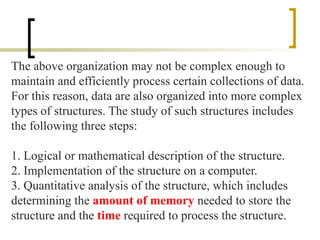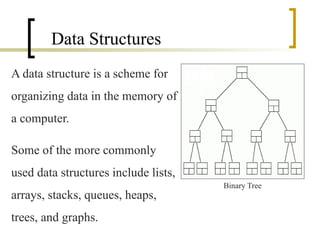INTRODUCTION TO DATA STRUCTURE & ABSTRACT DATA TYPE.pptx
- 1. Introduction to Data Structure Lecture 1 DATA STRUCTURE & ABSTRACT DATA TYPE
- 2. Basic Terminologies Data are simply values or set of values. A data item refers to a single unit of values. Data items that are divided into sub items are called group items; those that are not are called elementary items. An entity is something that has certain attributes or properties which may be assigned values. The values themselves may be numeric or non numeric. Entities with similar attributes form an entity set. Each attribute of an entity set has a range of values, the set of all possible values that could be assigned to the particular attribute
- 3. The term information is used for data with given attributes, or in other words meaningful or processed data. A field is a single elementary unit of information representing an attribute of an entity. A record is a collection of field values of a given entity
- 4. A file is the collection of records of the entities in a given entity set. Each record in a file may contain many field items, but the value in a certain field may uniquely determine the record in the file. Such a field is called primary key.
- 5. The above organization may not be complex enough to maintain and efficiently process certain collections of data. For this reason, data are also organized into more complex types of structures. The study of such structures includes the following three steps: 1. Logical or mathematical description of the structure. 2. Implementation of the structure on a computer. 3. Quantitative analysis of the structure, which includes determining the amount of memory needed to store the structure and the time required to process the structure.
- 6. How do we organize information so that we can find update, add, and delete portions of it efficiently?
- 7. Data Structure Example Applications How does Google quickly find web pages that contain a search term? What’s the fastest way to broadcast a message to a network of computers? How does your operating system track which memory (disk or RAM) is free?
- 10. Data Structures A data structure is a scheme for organizing data in the memory of a computer. Some of the more commonly used data structures include lists, arrays, stacks, queues, heaps, trees, and graphs. Binary Tree
- 11. Data Structures The way in which the data is organized affects the performance of a program for different tasks. Computer programmers decide which data structures to use based on the nature of the data and the processes that need to be performed on that data. Binary Tree
- 12. What is a Data Structure It’s an agreement about: how to store a collection of objects in memory, what operations we can perform on that data, the algorithms for those operations, and how time and space efficient those algorithms are.
- 13. Data Structure Design Specification A set of data Specifications for a number of operations to be performed on the data Design A lay-out organization of the data Algorithms for the operations Goals of Design: fast operations 13
- 14. Data Structure Aggregation of atomic and composite data into a set with defined relationships. Structure refers to a set of rules that hold the data together. • A combination of elements in which each is either a data type or another data structure. • A set of associations of relationship involving combined elements. • structure means a set of rules that holds the data together. In other words, if we take a group of data and fit them into a structure such that we can define its relating rules, we have made a data structure
- 15. Data Structures Data may be organized in many different ways; the logical or mathematical model of a particular organization of data is called a data structure. The choice of a particular data model depends on two considerations. 1. It must be rich enough in structure to mirror the actual relationships of the data in the real world. 2. The structure should be simple enough that one can effectively process the data when necessary.
- 16. Implementation of a Data Structure For the word Implementation we think in two aspects, Hardware Implementation and Software Implementation. 1. Hardware Implementation: In hardware implementation the circuit which performs the required operation is designed and constructed as part of a computer. 2. Software Implementation: In software implementation in which program consisting of already existing hardware instructions is written to interpret bit strings in the desired fashion and to perform the required operations. Thus a software implementation includes a specification or structure that how an object of the new data type is represented. 16
- 17. 17 The Abstract Data Type In any programming language there are many native data types defined by the vendors of the language to facilitate the programmers. The most common data types are int , float, boolean, char and string etc. When an application requires a special kind of data which is not available as built-in data types then it is the programmer burden to implement his own kind of data. Programmers own data type is termed as abstract data type.
- 18. Abstract data type (ADT) is also called as user defined data type. In structural languages programmer used structure for abstract data type. While in Object Oriented Programming (OOPs) languages, programmers has both options to use structures as well as classes for user defined data types. For example in C/C++ language we use structure for stack, because there is no built-in data types for stack.
- 19. why data structures Data structures help us to organize the data in the computer, resulting in more efficient programs. An efficient program executes faster and helps minimize the usage of resources like memory, disk. Computers are getting more powerful with the passage of time with the increase in CPU speed in GHz, availability of faster network and the maximization of disk space. Therefore people have started solving more and more complex problems.
- 20. As computer applications are becoming complex, so there is need for more resources. This does not mean that we should buy a new computer to make the application execute faster. Our effort should be to ensue that the solution is achieved with the help of programming, data structures and algorithm.





















